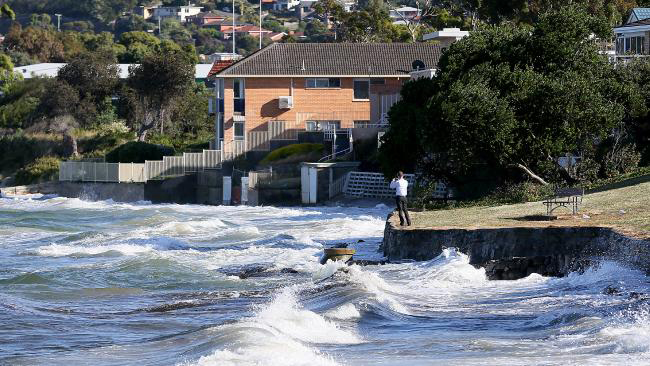The inevitability of future sea level rise requires action now.

Storm surge at Howrah Beach during a wild weather event in December 2016. PHOTO Sam Rosewarne, The Mercury
I take my hat off to Hobart City for its persistent efforts to get its people engaged with that bothersome matter of climate change, specifically what it will do to low-lying coastal land.
Last time they tried a coastal community forum, for residents of highly-priced, highly-susceptible Nutgrove in lower Sandy Bay, they didn’t get the level of engagement they hoped for.
This week they’re trying again, this time with people living between Wrest Point and Battery Point, including another bit of low-lying real estate, Marieville Esplanade.
To get the ball rolling they’ve released an assessment of the precinct’s “coastal adaptation pathways” for coming decades. Residents wanting to learn more are invited to a “drop-in” at the Derwent Sailing Squadron on Marieville Esplanade from 2 pm this Thursday and Friday.
The Marieville Esplanade Coastal Adaptation Pathways (MECAP) analysis uses the government’s sea level rise planning allowances of 0.2 m higher by 2050 and 0.8 m higher by 2100. The additional impact of river flooding, storm surge and king tides isn’t included in those figures.
What do our rising seas have in store for these much-desired parts of our coastal cities? MECAP cites projections by the Bureau of Meteorology, CSIRO and international agencies, but any property owners who want certainty will be disappointed, because there isn’t any.
Evidence from ages past, however, does indicate where we’ll finish up. In the Pliocene epoch, from three to five million years ago, temperatures were about the same as today and carbon dioxide in the air peaked about where it is now – and the global ocean was at least five metres higher.
Past warm periods show that for every 1C of temperature rise, sea level is between 2.5 and 5 m higher. Warming is now on a trajectory that would take us well above 2C, so we should expect sea levels eventually to be at least 5 m higher than today and probably much more.
Science tells us nothing like that will happen within the lifetime of anyone alive today, but it will happen. While the annual rise in sea level today is measured in millimetres (currently about 3.2 mm), one day it will be in centimetres, and eventually we may be describing it in tens of centimetres.
After 2000 years of very stable sea levels, now they’re on the move. Scientists are bothered, but people and governments, on the whole, aren’t. Another journey back to the distant past may throw some light on this.
Daniel Gilbert, a psychology professor at Harvard University, says that over many millennia humans have evolved a powerful ability to respond and adapt to many threats, but those threats are mostly about other people and animals and current events. They don’t include a changing climate.
Our brain, says Gilbert, has evolved to deal with things that are intentional, immoral, imminent and instantaneous. We’ve learned to be sensitive to other people’s intentions, to right and wrong behaviour, and to things that are happening now and happening quickly.
Rising sea level is none of these things, but as Gilbert points out, a newly-evolved part of our brain, the prefrontal cortex, gives us the ability to conceive of past and future, enabling us to learn from past experiences and imagine how we can influence the future – as MECAP seeks to do.
To clarify the path ahead MECAP offers three options: plan and execute an early retreat, or protect what we have and disallow new development, or do the same while allowing development. The first option will cost much less than the last, but none will be cheap and all will involve some pain.
Hobart City could have taken a fourth option: do nothing at all and let people fend for themselves. But like all Tasmanian local authorities responsible for coastal lands, it knows that would be a fool’s choice.
FUTURE ENERGY pathways for Tasmania is the subject of a public discussion at IMAS (Castray Esplanade, Hobart, 5.30 pm Thursday) organised by the University of Tasmania’s Institute for the Study of Social Change and led by an expert panel including Tony Wood, energy director for Melbourne’s Grattan Institute.
